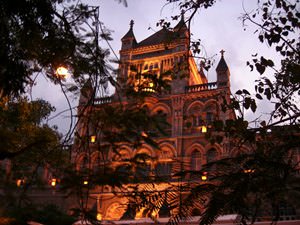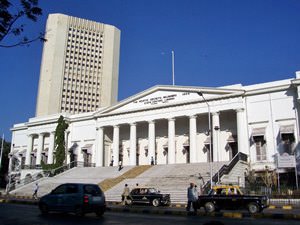 The cultural capital of India - Bombay – never ceases to attract travelers by dozens of iconic architectural and cultural landmarks. Gateway of India, Taj Mahal Palace, Central railway station, and Mumbadevi Temple is, by far, not the complete collection of objects of interest. In this review, we will try to include descriptions of the most important architectural landmarks of Bombay. We accompany them with interesting facts, colorful photographs, and 3D virtual tours. These 3D tours allow you observing the landmarks from a bird’s eye view. Simply turn on the HD video and enjoy the flight!
The cultural capital of India - Bombay – never ceases to attract travelers by dozens of iconic architectural and cultural landmarks. Gateway of India, Taj Mahal Palace, Central railway station, and Mumbadevi Temple is, by far, not the complete collection of objects of interest. In this review, we will try to include descriptions of the most important architectural landmarks of Bombay. We accompany them with interesting facts, colorful photographs, and 3D virtual tours. These 3D tours allow you observing the landmarks from a bird’s eye view. Simply turn on the HD video and enjoy the flight!
Gateway of India, Bombay
Location on the map:  Facts:
Facts:
» In December 1911, King George V made a friendly visit to Bombay. The Gateway of India was constructed in commemoration of this event. » The construction lasted 13 years. It was completed with the festive opening ceremony in 1924.
» The Gateway of India has a historical value, as soldiers of the British Army left the country through it.
» It was made of yellow basalt stone. The big arch is carved in it. The Gateway is decorated with multiple pictures. It is located on the embankment of Mumbai (Bombay).
» The giant triumphant arch is 26 m high. Its exterior facade is characterized by the combination of different architectural styles: Muslim, Indian, and Jewish. The massive platform ends with towers. The foundation of the platform continues with the steps leading to the water.
» The Gateway is covered with the dome that is 15 m high and has a diameter of 25 m. The arch at the sides has free recesses. They accommodate 600 people.
» Traditionally, ships and governors of India go through the Gateway.
» According to one legend, if you enter the Gateway with good intentions, the city will be hospitable to you. Say goodbye to the citizens in thoughts when leaving the megacity.
Taj Mahal Palace, Bombay
Location on the map:  Facts:
Facts:
» The hotel called “Taj Mahal Palace & Tower” started to be built in 1898. It opened its doors in 1903. » The building is famous for the visits of the Royal family. Here, banquets were held for Indian high society. August 1947 is a historic date. The political freedom of India was proclaimed exactly in the Taj Mahal Palace & Tower.
» The hotel is an architectural monument, as it is characterized by the combination of different styles. The Taj Mahal Palace & Tower features many elegant arches, domes, and balconies. Columns upholding the dome are made of onyx. The massive doors are decorated with carved paintings. The interior impresses with rich design. It is decorated with many semi-precious stones. The floor is covered with a home-made carpet. In the rooms, there are crystal chandeliers and antique pieces of furniture.
» It was the first time when modern lighting appeared in the building.
» Historic objects and valuable pieces of art are displayed.
» The rooms are cleaned 8 times a day. The walls in bathrooms are covered with Italian tiles.
» The convenient location of the hotel (on the embankment) attracts many tourists.
Central railway station, Bombay
Facts: » Mumbai Central is a railway station that links a range of cities. It is considered as an architectural monument because it was built in the colonial era, in the period of the British rule in India.
» The English started to build the railway from Bombay so far into the country in the middle of the 19th century.
» The building itself was constructed in 1876. It was completed at the date of the 50th Anniversary of Victoria’s reign. The construction lasted 9 years.
» The railway station is still open for tourists. It is the final destination point of the city Bombay Railway. This is the only railway, by which you can travel from one district to another.
» Not so long ago, the railway station received the name of the national hero of the 17th century, Chhatrapati Shivaji Terminus, or CST.
» It features a mixture of different architectural styles: New Gothic, Italian, and Indian. With its exterior, the building resembles a luxury palace but not a strict state institution.
» It is also characterized by carved wood, sculptures, railings, and grids decorated with patterns. The walls are faced with ceramics. There are many towers and arched hallways.
Mumbadevi Temple, Bombay
Facts: » “Mumba” means “the Great Mother of everything”. This is the name of the goddess, the local incarnation of Devi. The temple was built and named after her. This is also the name of the city, Mumbai (previously, Bombay) and, as the legend says, of the woman who encouraged the construction of the temple.
» The Mother Goddess defended salt miners and patronized anglers. They were the main group in the city.
» There is the two-meter statue of Mumba in the temple. It is made of black stone. Its head is decorated with a silver wreath. There are golden rings on the fingers and toes and a precious necklace on the neck. The figure is dotted with orange and yellow marigold leaves.
» The idol is surrounded by other goddesses. One of them is riding a peacock. Near it, there is the statue of the simian creature and the god of wisdom and wealth.
» The sanctuary is modestly decorated. There are almost no decorative elements. The rectangular temple is built of white stone. There is a tower in the tower of the pyramid at the top. There is a flag atop. Massive vertical ledges are the foundation of the construction.
» The entrance to Devi’s room is guarded by a sculptural tiger. The goddess rode it.
» Unlike the interior, the exterior of the temple impresses with plenty of intricate elements.
» Mumba has been revered since the 15th century.
St. Thomas Cathedral, Bombay
Facts: » St. Thomas Cathedral is a Christian church built in 1796. It was consecrated in the name of Apostle Thomas. He came to India to propagate the faith in Christ.
» The building was built by the British. Before that, the ruler in Bombay had intended to build the House of God for the English community.
» The construction lasted 40 years.
» You can see a lot of statues in wall recesses. The walls are decorated with bas-reliefs in Eastern style. There are high narrow windows. You can see figures of saints on stained glass windows. The vaulted ceiling is upheld by stone columns with arched soffits. The walls in the main halls are covered with carved panels.
» In the inner space, you can see stone sculptures. There is the preserved picture of the first bishop lying in the bed.
» The roof is tiled. There are also patios with fountains inside.
» In the territory of the cathedral, there are preserved memorial heave marble slabs with plates in honor of the dead British subjects.
» After some time, the magnificent tower was constructed. There is a clock on it. The first worship took place at Christmas. The cathedral was built in the center of the former fortress.
» The last reconstruction was paid by the United Nations Convention.
Rajabai Clock Tower, Bombay
Facts: » The Rajabai Clock Tower resembles Big Ben, a renowned clock tower in London.
» The construction of the Rajabai Tower was conceived in 1869. It was hard to implement the design architecturally, therefore the construction lasted for ten years and was completed in 1878.
» The 85-metre tower and the library extension adjoining it are made of yellow and orange stone. It was brought from a suburban quarry.
» The tower consists of 3 parts: the lower one that is 20 metres high, the middle level with a clock, and the upper one ending with a statue instead of a spire. There are eastern figures on the facade. The first part of the tower has lots of stained glass windows. There are two rooms on the first floor. They are located opposite each other. A spiral staircase goes up from the lobby.
» An Indian businessman made a significant financial contribution to the construction. The tower is named for the millionaire’s mother. The clock is mainly used to determine what time it is. Eating after sunset is forbidden for religious reasons.
» The tower clock originally had 16 tunes. Nowadays, one melody plays every 15 minutes.
» The internal entrance is closed for safety reasons. In the past, many people committed suicide from there.
Building of High Court, Bombay
Facts: » Queen Victoria ordered to build the court building in 1862 as an institution of supreme authority.
» 75 officials can simultaneously conduct trials at the court. More than 300,000 cases were conducted during the time of its existence.
» The exterior of the building resembles a European medieval castle. The only difference is that it’s surrounded by palm trees. It’s an elongated square that is 171 metres long. High walls prop a pyramidal roof. It’s covered with red tiles.
» The building has a strict appearance. But two eight-angle picturesque towers at the top of it stand out from the rest of the exterior. They are decorated with pointed triangular gables.
» The sculptures of goddesses are signs of justice and mercy. There’s a one-eyed monkey among them. It plays with scales of justice.
» Various exhibitions are held here. For example, an exhibition of Indian postage stamps, geographical maps. To celebrate the 150th anniversary of the court, a permanent exhibition of court-related items and written testimony having a historical value was organized in the central hall.
» The building has a spacious field where you can play cricket (a game with a ball and a bat).





